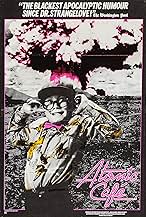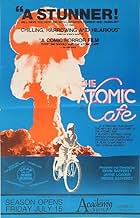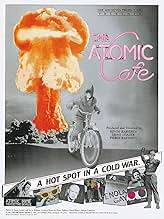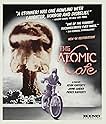IMDb-BEWERTUNG
7,6/10
4746
IHRE BEWERTUNG
Füge eine Handlung in deiner Sprache hinzuDisturbing collection of 1940s and 1950s United States government-issued propaganda films designed to reassure Americans that the atomic bomb was not a threat to their safety.Disturbing collection of 1940s and 1950s United States government-issued propaganda films designed to reassure Americans that the atomic bomb was not a threat to their safety.Disturbing collection of 1940s and 1950s United States government-issued propaganda films designed to reassure Americans that the atomic bomb was not a threat to their safety.
- Regie
- Hauptbesetzung
- Nominiert für 1 BAFTA Award
- 2 Gewinne & 1 Nominierung insgesamt
Paul Tibbets
- Self
- (Archivfilmmaterial)
Harry S. Truman
- Self
- (Archivfilmmaterial)
- (as President Harry S Truman)
W.H.P. Blandy
- Self - Commander of the Bikini Test
- (Archivfilmmaterial)
- (as Vice Admiral W.H.P. Blandy)
Brien McMahon
- Self
- (Archivfilmmaterial)
- (as Sen. Brian McMahon)
Lloyd Bentsen
- Self
- (Archivfilmmaterial)
- (as Rep. Lloyd Bentsen)
Owen Brewster
- Self
- (Archivfilmmaterial)
- (as Sen. Owen Brewster)
Julius Rosenberg
- Self
- (Archivfilmmaterial)
Ethel Rosenberg
- Self
- (Archivfilmmaterial)
Val Peterson
- Self - Director of Civil Defense
- (Archivfilmmaterial)
- (as Gov. Val Peterson)
Lyndon B. Johnson
- Self
- (Archivfilmmaterial)
- (as Sen. Lyndon B. Johnson)
Lewis Strauss
- Self - Chairman, Atomic Energy Commission
- (Archivfilmmaterial)
- (as Lewis L. Strauss)
George Molan
- Self
- (Archivfilmmaterial)
- (as Cpl. George Molan)
George Portell
- Self
- (Archivfilmmaterial)
- (as Tech Sgt. George Portell)
Jerry Schneider
- Self
- (Archivfilmmaterial)
Sergeant Weaver
- Self
- (Archivfilmmaterial)
Seymour Melman
- Self - Columbia University
- (Archivfilmmaterial)
- (as Prof. Seymour Melman)
Mario Salvadori
- Self - Columbia University
- (Archivfilmmaterial)
- (as Prof. Mario Salvadori)
Nikita Khrushchev
- Self
- (Archivfilmmaterial)
Empfohlene Bewertungen
A great look into the ultra-paranoid mindset of the Cold War which I lived through. It is truly amazing how such madness (paranoia and intolerance of someone who dares to exercise REAL freedom of speech, of which examples are clearly shown) was accepted in those times.
The "Bert the Turtle" sequence cracked me up. I REMEMBER doing this "Duck and Cover" idiocy! When I was in grade school, we had Civil Defense drills: we were taught to leave the classroom, go out in the hall, face the wall, lean against it and cover our faces with our folded arms. Never you mind that the wall that was behind us consisted mostly of window glass! A shockwave hitting it would have blasted the shards into our backs. It would have looked like the St. Valentine's Day Massacre!
A great film.
The "Bert the Turtle" sequence cracked me up. I REMEMBER doing this "Duck and Cover" idiocy! When I was in grade school, we had Civil Defense drills: we were taught to leave the classroom, go out in the hall, face the wall, lean against it and cover our faces with our folded arms. Never you mind that the wall that was behind us consisted mostly of window glass! A shockwave hitting it would have blasted the shards into our backs. It would have looked like the St. Valentine's Day Massacre!
A great film.
The fact that this is true makes this short film scary and worrying...but doesn't stop it from being very entertaining and funny. The pieces of real life propaganda are amazing and it's often hard to believe that it's all true.
However remember that all of the snipets of film are cut and pasted together with music added over the top, so everything you see isn't exactly as it seems... it's propaganda on propaganda...and highly entertaining. A must see for any one interested in American History, Propaganda, or just wanting a good sorry laugh.
However remember that all of the snipets of film are cut and pasted together with music added over the top, so everything you see isn't exactly as it seems... it's propaganda on propaganda...and highly entertaining. A must see for any one interested in American History, Propaganda, or just wanting a good sorry laugh.
10enmussak
For anyone who enjoys a real sense about times in history that they have not lived through, this is an excellent film. I had no idea how the dawning of the atomic age changed American culture. For an interesting continuance of the paranoid atomic era, check out Bowling for Columbine. Both Atomic Cafe and Bowling for Columbine discuss the "Culture of Fear" that is America.
Some of the content in the Atomic Cafe is completely shocking, which serves its purpose as a poignant exposé into one of the darker periods of America's (if not the world's history). A must see. You'll be glued to the screen. 10/10
Some of the content in the Atomic Cafe is completely shocking, which serves its purpose as a poignant exposé into one of the darker periods of America's (if not the world's history). A must see. You'll be glued to the screen. 10/10
I could watch this movie again and again. If you remember the days when we were all terrified of impending nuclear war with the Soviet Union, this puts your half-remembered anxieties and prejudices in perspective. There's rare archive footage of the first nuclear bombs being primed and detonated. There's stomach churning archive footage about the execution of the Rosenbergs for espionage. And the now hilarious footage about how civilians should protect themselves against the bomb. Makes fun of politicians and broadcasters, and leaves you feeling that you've learned something and that you won't be fooled again.
Watching Atomic Café is like witnessing history repeating, since the scenes are a compilation of bits and pieces from pre-existing films taken from government and education films from the '40s and '50s. As a compilation film, Atomic Café has resulted in a totally new film that is much richer and more meaningful than the sum of its parts.
Atomic Café, will be more understandable if we are familiar with the roots of its historical material. As a history film, Atomic Café takes us to experience three levels of time. The first is the internal time, the Cold War, communism versus the free world, when propaganda about the atomic bomb was made to persuade the people that only nuclear weapons would protect them from the "Evil Empire". The period of the'Nuclear Free' movement comes next. And thirdly, the present time, when the world is changed but has to face the same irony that still is just as relevant today, the fear of weapons of mass destruction.
In the beginning, the film appears to be a straightforward history of America's development and use of atomic weapons. Historical footage is used to add credibility to the information presented. The power of the bomb is demonstrated by showing dramatic footage of the Trinity test; interviews with Bikini Islanders, and preserved eyewitness congressional testimony of atomic bomb veterans. The impact of the weapon is documented through footage of the bomb victims. The intention is not to make us become objective about certain issues, rather it 'is designed to make us question the nature of the information presented' (Freeman Reading Packet, 108).
The film uses unique techniques. It is like a collage that 'sacrifices the conventions of continuity editing and the sense of a very specific location in time and place that follows from it to explore associations and patterns that involve temporal rhythms and spatial juxtaposition' (Nichols, 102). It is all about editing raw material and splicing segments? of military training films, civil defense films, archive footage, interviews, newsreel material, and fifties music. Many sequences are edited to show the most ridiculous side of the duck-and-cover drills and how naïve the Americans were at that time. To make it more derisive the film shows how the military training films were so amateurishly acted and misleading, such as the scene about the beauty of the H-bomb. I believe that the filmmakers have made their point in choosing all the footage for the film. Perhaps the intention is to challenge and deprive the intended message of the original footage.
If we take a look in more detail, Atomic Café chooses and juxtaposes its various elements to support its point-of-view. One of the examples is the continual references to radio receivers. Perhaps it is a symbol that is used to invoke the idea of the power of mass media. The intention is 'to sensitize us to the danger of uncritical media consumption' (Freeman Reading Packet, 110). It is so ironic to see how people in the '50s could be so passive that they believed in every single thing that they heard about the atom bomb on the radio. We can see from the footage how people became so afraid and escaped to their shelter after hearing that a bomb was launched. Perhaps fear had taken such control of these people that the more frightened they were, the more they were easily persuaded.
I guess it would be a great mistake to ignore the political message that is contained in the film. Maybe for some viewers this is just a gimmick about the Cold War and things that happens during the '50's. But really, Atomic Café gives us an historical perspective for reconsidering the effect of the issues of war, nuclear warfare and weapons of mass destruction.
Atomic Café, will be more understandable if we are familiar with the roots of its historical material. As a history film, Atomic Café takes us to experience three levels of time. The first is the internal time, the Cold War, communism versus the free world, when propaganda about the atomic bomb was made to persuade the people that only nuclear weapons would protect them from the "Evil Empire". The period of the'Nuclear Free' movement comes next. And thirdly, the present time, when the world is changed but has to face the same irony that still is just as relevant today, the fear of weapons of mass destruction.
In the beginning, the film appears to be a straightforward history of America's development and use of atomic weapons. Historical footage is used to add credibility to the information presented. The power of the bomb is demonstrated by showing dramatic footage of the Trinity test; interviews with Bikini Islanders, and preserved eyewitness congressional testimony of atomic bomb veterans. The impact of the weapon is documented through footage of the bomb victims. The intention is not to make us become objective about certain issues, rather it 'is designed to make us question the nature of the information presented' (Freeman Reading Packet, 108).
The film uses unique techniques. It is like a collage that 'sacrifices the conventions of continuity editing and the sense of a very specific location in time and place that follows from it to explore associations and patterns that involve temporal rhythms and spatial juxtaposition' (Nichols, 102). It is all about editing raw material and splicing segments? of military training films, civil defense films, archive footage, interviews, newsreel material, and fifties music. Many sequences are edited to show the most ridiculous side of the duck-and-cover drills and how naïve the Americans were at that time. To make it more derisive the film shows how the military training films were so amateurishly acted and misleading, such as the scene about the beauty of the H-bomb. I believe that the filmmakers have made their point in choosing all the footage for the film. Perhaps the intention is to challenge and deprive the intended message of the original footage.
If we take a look in more detail, Atomic Café chooses and juxtaposes its various elements to support its point-of-view. One of the examples is the continual references to radio receivers. Perhaps it is a symbol that is used to invoke the idea of the power of mass media. The intention is 'to sensitize us to the danger of uncritical media consumption' (Freeman Reading Packet, 110). It is so ironic to see how people in the '50s could be so passive that they believed in every single thing that they heard about the atom bomb on the radio. We can see from the footage how people became so afraid and escaped to their shelter after hearing that a bomb was launched. Perhaps fear had taken such control of these people that the more frightened they were, the more they were easily persuaded.
I guess it would be a great mistake to ignore the political message that is contained in the film. Maybe for some viewers this is just a gimmick about the Cold War and things that happens during the '50's. But really, Atomic Café gives us an historical perspective for reconsidering the effect of the issues of war, nuclear warfare and weapons of mass destruction.
Wusstest du schon
- WissenswertesThe segment "Duck and Cover" showed how school children were reassured by "Bert the Turtle" that they would survive a nuclear bomb by simply forming a huddle together by the wall of the school-house. "The Atomic Cafe" has been attributed to raising public consciousness of the short film "Duck and Cover" and introducing it to a whole a new generation.
- Zitate
Army information film: When not close enough to be killed, the atomic bomb is one of the most beautiful sights in the world.
- SoundtracksWhen the Atom Bomb Fell
Written by Karl Victor Davis and Connecticut 'Harty' Taylor
Performed by Karl and Harty
Courtesy of CBS Records, Inc.
Top-Auswahl
Melde dich zum Bewerten an und greife auf die Watchlist für personalisierte Empfehlungen zu.
- How long is The Atomic Cafe?Powered by Alexa
Details
Box Office
- Budget
- 300.000 $ (geschätzt)
- Bruttoertrag in den USA und Kanada
- 22.293 $
- Eröffnungswochenende in den USA und in Kanada
- 4.098 $
- 5. Aug. 2018
- Weltweiter Bruttoertrag
- 22.293 $
- Laufzeit
- 1 Std. 26 Min.(86 min)
- Farbe
- Sound-Mix
- Seitenverhältnis
- 1.33 : 1
Zu dieser Seite beitragen
Bearbeitung vorschlagen oder fehlenden Inhalt hinzufügen




























